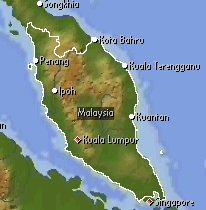
Malaysia
Stats & Facts Physical Economy History

Lonely Planet - Map of Malaysia


Malaysia is a country in south-east Asia, having two parts, West and East, separated by the South China Sea.
Statistics & Facts
Capital : Kuala Lumpur
Area : 330,442 km2 (127,584 sq. mi.)
Population : 19.948 million (1995)
Currency : 1 ringgit = 100 sen
Religions : Muslim 52.9%; Buddhist 17.3%; Chinese popular religions 11.6%; Hindu 7.0%; Christian 6.4%
Ethnicity : Malay, Orang Asli, Iban, Land Dayak, Bajan, and Kadazan 60.0% Chinese 31.0%; Indian, Pakistani, and Bangladeshi 8.0%
Languages : Malay (official); English; Chinese; Tamil; minority languages
International Organizations : UN; Commonwealth; Non-Aligned Movement; Colombo Plan; ASEAN
Physical
East Malaysia comprises Sarawak and Sabah in the north and north-west of the island
of Borneo. West, or Peninsular, Malaysia comprises the former Federation of Malaya
and occupies the southern end of the Malay Peninsula, extending south from the south-east
Asian mainland and bounded on the north by Thailand and on the south by Singapore; it
has a south-western coast on the Strait of Malacca. The climate of Malaysia is very
warm and affected by the monsoons, which bring about 2,300 mm (90 inches) of rain in
a year. The red soil provides for paddy-fields in the lowland areas, where rice is
cultivated, and high-yield rubber, oil palm, and cocoa plantations in the west of
the peninsula, tin is also dredged. Inland, the Malayan highlands are forested and
provide tropical hardwoods. East Malaysia and off-shore waters are rich in mineral
oil.
Economy
Manufacturing industry produces automobiles, electronics, cigarettes, tyres, sawn logs,
and cement. Crude oil is an important export. Agriculture, with rice the principal
subsistence crop, remains the mainstay of the economy, despite high industrial growth
in recent years. Malaysia is the world's largest producer of rubber, palm oil, and
tin; timber is also an important export. Other mineral resources include bauxite,
iron ore, and copper. The New Economic Policy (NEP), initiated after ethnic riots
in 1970, introduced ethnic quotas in an attempt to promote economic growth and
eradicate the association of race with occupation.
History
Established in 1963, the Federation of Malaysia originally included Singapore but
it was forced to secede in 1965 because of fears that its largely Chinese population
would challenge Malay political dominance. Brunei refused to join the Federation. The
establishment of Malaysia was first suggested (1961) by Tungku Abdul Rahman, who
became its first Prime Minister (1963-70). The Federation aroused deep suspicion in
Indonesia, and provoked President Sukarno's policy of confrontation (Konfrontasi),
resulting in intermittent guerrilla war in Malaysia's Borneo territories which was
only defeated with Commonwealth military assistance (1963-6). In 1969, inequalities
between the politically dominant Malays and economically dominant Chinese resulted
in riots in Kuala Lumpur, and parliamentary government was suspended until 1971. As
a result, there was a major restructuring of political and social institutions
designed to ensure Malay predominance, the New Economic Policy being launched to
increase the Malay (bumiputra) stake in the economy. The largest single political
party remained the United Malays National Organization, which had been created by
Tunku Rahman. Since 1971 this has ruled in uneasy alliance with the Malaysian
Chinese Association and some other ten parties in a coalition, the National Front.
Mahathir bin Mohamed became its leader and Prime Minister in 1981. A leading member
of the Association of South-east Asian Nations, Malaysia replaced the New Economic
Policy in 1991 by a New Development Policy, whose aim was to diversify the economy.
At the same time it has incurred international criticism for its exploitation of
its rain-forests. During 1994 a scandal over Britain's lending Malaysia #234 million
to build the Pergau dam in an aid-for-trade agreement caused controversy in Britain
and strained relations between the two countries. The ruling coalition was
re-elected in 1995. In September 1997 the Malaysian stock market and currency
crashed, precipitating an economic and political crisis.